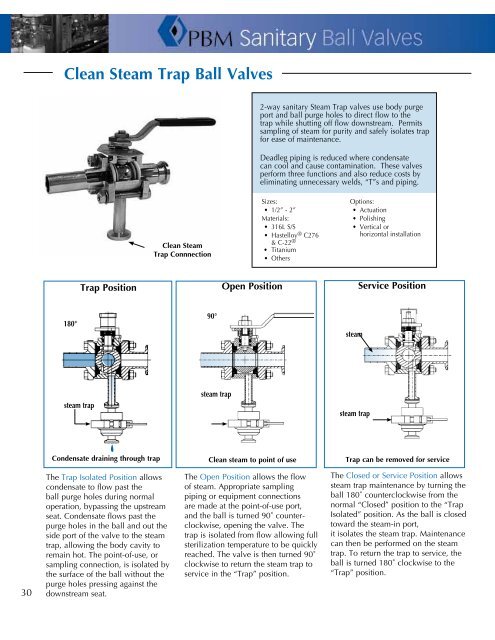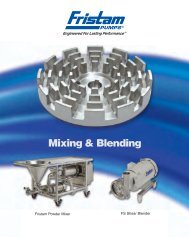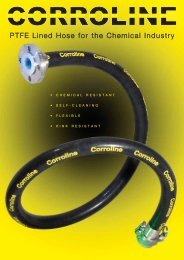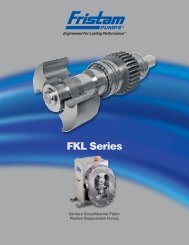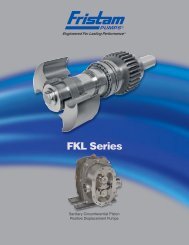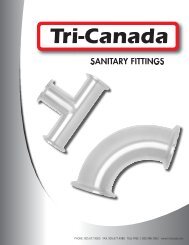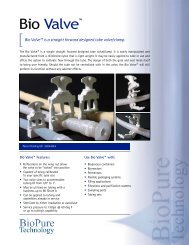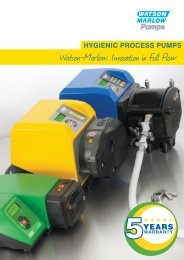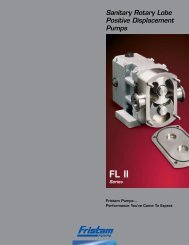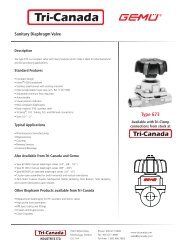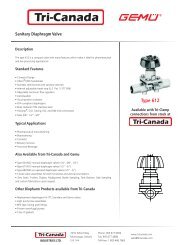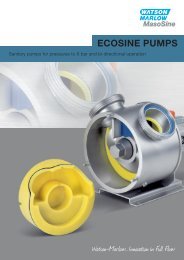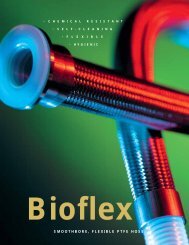PBM Sanitary Ball Valves - Tri-Canada
PBM Sanitary Ball Valves - Tri-Canada
PBM Sanitary Ball Valves - Tri-Canada
You also want an ePaper? Increase the reach of your titles
YUMPU automatically turns print PDFs into web optimized ePapers that Google loves.
Clean Steam Trap <strong>Ball</strong> <strong>Valves</strong><br />
2-way sanitary Steam Trap valves use body purge<br />
port and ball purge holes to direct flow to the<br />
trap while shutting off flow downstream. Permits<br />
sampling of steam for purity and safely isolates trap<br />
for ease of maintenance.<br />
Deadleg piping is reduced where condensate<br />
can cool and cause contamination. These valves<br />
perform three functions and also reduce costs by<br />
eliminating unnecessary welds, “T”s and piping.<br />
Clean Steam<br />
Trap Connnection<br />
Sizes:<br />
• 1/2” - 2”<br />
Materials:<br />
• 316L S/S<br />
• Hastelloy ® C276<br />
& C-22 ®<br />
• Titanium<br />
• Others<br />
Options:<br />
• Actuation<br />
• Polishing<br />
• Vertical or<br />
horizontal installation<br />
Trap Position<br />
Open Position<br />
Service Position<br />
180°<br />
90°<br />
steam<br />
steam trap<br />
steam trap<br />
steam trap<br />
Condensate draining through trap<br />
Clean steam to point of use<br />
Trap can be removed for service<br />
30<br />
The Trap Isolated Position allows<br />
condensate to flow past the<br />
ball purge holes during normal<br />
operation, bypassing the upstream<br />
seat. Condensate flows past the<br />
purge holes in the ball and out the<br />
side port of the valve to the steam<br />
trap, allowing the body cavity to<br />
remain hot. The point-of-use, or<br />
sampling connection, is isolated by<br />
the surface of the ball without the<br />
purge holes pressing against the<br />
downstream seat.<br />
The Open Position allows the flow<br />
of steam. Appropriate sampling<br />
piping or equipment connections<br />
are made at the point-of-use port,<br />
and the ball is turned 90˚ counterclockwise,<br />
opening the valve. The<br />
trap is isolated from flow allowing full<br />
sterilization temperature to be quickly<br />
reached. The valve is then turned 90˚<br />
clockwise to return the steam trap to<br />
service in the “Trap” position.<br />
The Closed or Service Position allows<br />
steam trap maintenance by turning the<br />
ball 180˚ counterclockwise from the<br />
normal “Closed” position to the “Trap<br />
Isolated” position. As the ball is closed<br />
toward the steam-in port,<br />
it isolates the steam trap. Maintenance<br />
can then be performed on the steam<br />
trap. To return the trap to service, the<br />
ball is turned 180˚ clockwise to the<br />
“Trap” position.


